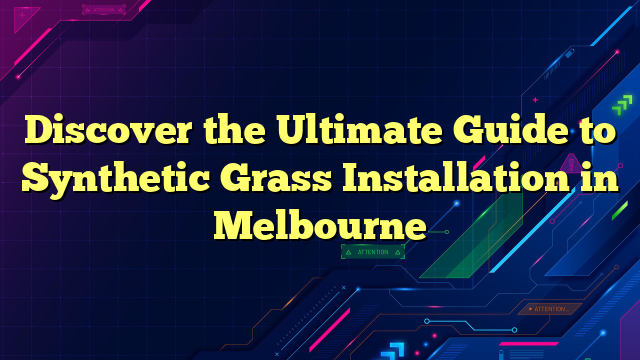Synthetic grass installation melbourne – Synthetic grass installation in Melbourne is revolutionizing outdoor spaces, offering a plethora of benefits and endless possibilities. Dive into this comprehensive guide to unravel the secrets of this innovative landscaping solution, from its advantages to installation techniques and maintenance tips.
From enhancing the aesthetics of your backyard to creating a low-maintenance oasis on your balcony, synthetic grass transforms outdoor areas into vibrant and functional havens.
Benefits of Synthetic Grass Installation: Synthetic Grass Installation Melbourne
Synthetic grass installation offers numerous advantages, transforming outdoor spaces with its durability, low maintenance, and cost-effectiveness. Unlike natural grass, synthetic turf can withstand heavy foot traffic, extreme weather conditions, and requires minimal upkeep. This makes it an ideal choice for busy homeowners, pet owners, and those seeking a low-maintenance landscape solution.
Enhanced Aesthetics and Functionality
Synthetic grass not only provides a durable and low-maintenance surface but also enhances the aesthetics and functionality of outdoor spaces. Its lush green appearance adds a touch of elegance to any backyard, creating a vibrant and inviting atmosphere. Furthermore, synthetic turf allows for versatile use, accommodating various activities such as sports, recreation, and relaxation, making it a perfect solution for families and individuals seeking a multi-purpose outdoor space.
Types of Synthetic Grass
Synthetic grass is a versatile and durable alternative to natural grass, offering a range of options to suit specific needs and preferences. Understanding the different types of synthetic grass available is crucial for making an informed decision.
Investing in synthetic grass installation in Melbourne is a wise decision that can not only enhance the aesthetic appeal of your property but also increase its value. According to property value melbourne experts, properties with well-maintained synthetic lawns have a higher market value compared to those with natural grass.
Moreover, synthetic grass requires minimal maintenance, saving you time and money, allowing you to enjoy a beautiful lawn without the hassle.
Nylon
- Nylon is a strong and durable synthetic grass, resistant to wear and tear.
- It has a natural appearance and feel, making it a popular choice for residential and commercial applications.
- Nylon is UV-resistant, ensuring colorfastness and longevity.
- However, nylon can be more expensive than other synthetic grass types.
Polyethylene
- Polyethylene is a softer and more pliable synthetic grass, providing a comfortable feel underfoot.
- It is less durable than nylon but more affordable.
- Polyethylene is UV-resistant and can withstand harsh weather conditions.
li>It is a good choice for areas with high foot traffic, such as playgrounds and sports fields.
Polypropylene, Synthetic grass installation melbourne
- Polypropylene is a budget-friendly synthetic grass option.
- It is durable and can withstand moderate wear and tear.
- Polypropylene is not as soft or natural-looking as nylon or polyethylene.
- It is a suitable choice for areas with lower foot traffic, such as balconies or patios.
Choosing the Right Synthetic Grass
The choice of synthetic grass depends on factors such as durability, comfort, budget, and intended use. Nylon is the best option for high-traffic areas and natural appearance, while polyethylene is ideal for comfort and affordability. Polypropylene is a cost-effective choice for low-traffic areas.
Installation Process
Installing synthetic grass involves several key steps, each crucial for ensuring durability and longevity. Proper site preparation, base installation, and grass laying techniques are essential for a successful installation.
The installation process can vary depending on the specific area where the synthetic grass is being installed, such as backyards, balconies, or rooftops.
Site Preparation
Before installing synthetic grass, it’s essential to prepare the site by removing existing vegetation, leveling the ground, and compacting the soil. This creates a stable and even base for the synthetic grass to be laid upon.
Base Installation
The next step is to install a base layer, which typically consists of crushed stone or recycled rubber. The base layer provides drainage, support, and cushioning for the synthetic grass.
Grass Laying
Once the base is installed, the synthetic grass is rolled out and cut to fit the desired area. It’s crucial to ensure the grass is laid in the correct direction and tensioned properly to prevent wrinkles or buckling.
Infill
After the grass is laid, an infill material, such as sand or recycled rubber, is applied to the surface. The infill helps weigh down the grass, prevent movement, and enhance its durability.
Finishing Touches
The final step involves brushing the grass to raise the fibers and give it a natural appearance. Seams between different pieces of grass are also joined together using specialized adhesives or tapes.
Maintenance and Care
Synthetic grass requires minimal maintenance compared to natural grass. However, proper care is essential to extend its lifespan and preserve its appearance.
Regular brushing helps remove dirt, debris, and fallen leaves, preventing the buildup that can dull the grass’s color and texture. Occasional cleaning with a mild detergent solution can further remove stubborn stains or dirt.
Periodic Inspections
Periodic inspections are crucial to identify any potential issues, such as tears, holes, or fading. Prompt repair or replacement can prevent further damage and maintain the grass’s overall integrity.
Cost and Considerations
Synthetic grass installation in Melbourne comes with a range of costs depending on factors like area size, grass type, and installation complexity. Budgeting for synthetic grass requires careful planning to ensure informed decisions.
Cost Factors
*
-*Area Size
Larger areas require more materials and labor, leading to higher costs.
-
-*Grass Type
Different synthetic grass types vary in quality, durability, and aesthetics, impacting the overall cost.
-*Installation Complexity
Uneven surfaces, obstacles, or intricate designs increase the difficulty of installation, resulting in additional labor costs.
Outcome Summary
Embark on the journey of synthetic grass installation in Melbourne, armed with the knowledge and insights gained from this guide. Whether you seek a lush backyard retreat or a practical solution for your urban oasis, synthetic grass offers a myriad of possibilities.
Embrace the benefits, explore the options, and create an outdoor space that seamlessly blends beauty and functionality.
